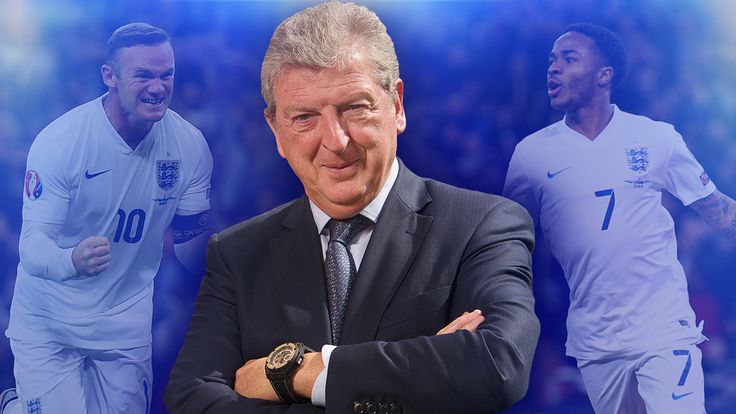
Wednesday 1 June 2016 11:08, UK
The prevailing mood demands that England play more attacking football but should Roy Hodgson’s side really just go for it? Caution wins tournaments, argues Adam Bate…
After England's World Cup elimination in Brazil, the consensus emerged quickly. Amid the usual talk of grass-roots issues, outrageous expectations and a general appetite for self-flagellation, there appeared an acceptance that a more ambitious approach was needed.
A number of top pundits and journalists were asked to pick their preferred line-up for the next World Cup. All but one went without a holding midfielder. Perhaps the only thing more damaging than failure is the inability to recognise the reasons for that failure.
It was a particularly perverse reaction given the evidence. After all, England had found the net in their defeats to both Italy and Uruguay. The more obvious problem had been the fact that Roy Hodgson's side were unable to negotiate a half of football without conceding.
Hodgson's reputation as a defensive coach overshadowed all. Even the decision to start with four forwards - Daniel Sturridge and Wayne Rooney were flanked by Danny Welbeck and Raheem Sterling - was not enough to shake off those familiar accusations.
In midfield, Hodgson went with a poor imitation of the Liverpool midfield that had so lit up the preceding season's Premier League. Steven Gerrard and Jordan Henderson were included, although there was no third player around to help them.
Predictably, they were unable to recreate the energy of the Reds in the sweltering humidity of Manaus. And it was the rest of the world left to reflect upon a tale of naivety not inertia; of recklessness rather than restraint.
FIFA's technical report recognised Sturridge, Rooney and Sterling as the team's standout performers, but England failed to recognise the clues. Others had been more discerning in their deployment of their attacking assets.
Argentina, for example, boasted the best player on the planet in Lionel Messi. And yet, they had still built their run to the World Cup final on a solid defensive structure. Barcelona centre-back Javier Mascherano played a key role in midfield.
Alongside him, the defensively savvy Lucas Biglia provided protection for the back line as Argentina kept three consecutive clean sheets on their way to the final. Two goals in the knockout stages were enough to take them to within a whisker of glory.
Instead, Jogi Low's Germany won out. But they too offered an example to England in their set-up. Toni Kroos had frequently been used in a midfield two at club level but was fielded as a No 10 for his country with Bastian Schweinsteiger and Sami Khedira providing cover.
This is a recurring theme for the most successful international teams. Vicente del Bosque's Spain side won a World Cup and a European Championship by playing Xabi Alonso alongside Sergio Busquets and Xavi in a congested midfield three.
The concept should not be anathema to England. Nicky Butt was the unexpected success story of the team's run to the quarter-finals of the 2002 World Cup, while both Michael Carrick and Owen Hargreaves enhanced their reputations in the role four years later.
In international football, the position has added importance. It's no mystery. It's an acknowledgement that control becomes more significant than attacking fluency; a recognition that defensive errors are more likely when teams are not so well organised.
As a result, the natural response to the problem is to add bodies in defensive zones. But not everyone is willing to accept this wisdom. So while some debate whether to field two holding midfielders or three, England have named a squad that includes only one: Eric Dier.
Two years on from that miserable showing in Brazil and there are worrying signs that the lessons have not been learnt. Would another serious contender risk utilising Jack Wilshere at the base of midfield? It's the reverse of what Spain and Germany did with Xavi and Kroos.
Then there is the example of Dele Alli. A revelation in his debut Premier League season, he enjoyed much success playing off Harry Kane in a No 10 role. However, he can expect to feature deeper in France despite not yet playing a single competitive game for his country.
While the trend at international level continues to be towards providing a solid platform, England are the team toying with the idea of using top scorer Rooney in midfield so that two more strikers can be shoehorned into an already defensively frail starting line-up.
Despite doing all of these things in the build-up to Euro 2016, Hodgson still faces familiar accusations of displaying a paucity of ambition. Once again pundits are seeking to squeeze four forwards into the team. Most agree it would've been cowardly not to take five strikers.
Optimism grows at the thought of such line-ups and England's coach is caught between satisfying this demand to abandon all caution or risk ridicule for holding the team back. Rinse and repeat. England's refusal to accept the reality risks undermining them once again.